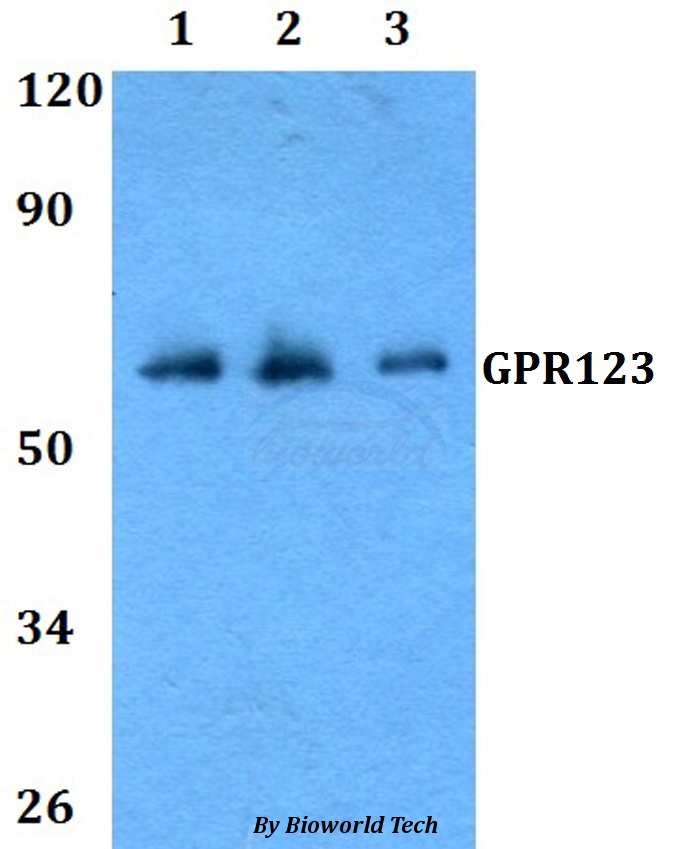Product Name :
GPR123 polyclonal antibody Background :
G protein-coupled receptors (GPRs), also known as seven transmembrane receptors, heptahelical receptors or 7TM receptors, comprise a superfamily of proteins that play a role in many different stimulus-response pathways. G protein coupled receptors translate extracellular signals into intracellular signals (G protein activation) and they respond to a variety of signaling molecules, such as hormones and neurotransmitters. GPR123 (G protein-coupled receptor 123) is a 1,279 amino acid multi-pass membrane protein belonging to the G-protein coupled receptor 2 family and LN-TM7 subfamily. Existing as two alternatively spliced isoforms, GPR123 functions as an orphan receptor that is expressed in adult and fetal brain, and in adult spinal cord. The gene encoding GPR123 maps to human chromosome 10q26.3 and mouse chromosome 7 F4. Product :
Rabbit IgG, 1mg/ml in PBS with 0.02% sodium azide, 50% glycerol, pH7.2 Storage&Stability :
Store at 4°C short term. Aliquot and store at -20°C long term. Avoid freeze-thaw cycles. Specificity :
GPR123 polyclonal antibody detects endogenous levels of GPR123 protein. Immunogen :
A synthetic peptide corresponding to residues in Human GPR123. Conjugate :
Unconjugated Modification :
Unmodification
GPR123 polyclonal antibody Background :
G protein-coupled receptors (GPRs), also known as seven transmembrane receptors, heptahelical receptors or 7TM receptors, comprise a superfamily of proteins that play a role in many different stimulus-response pathways. G protein coupled receptors translate extracellular signals into intracellular signals (G protein activation) and they respond to a variety of signaling molecules, such as hormones and neurotransmitters. GPR123 (G protein-coupled receptor 123) is a 1,279 amino acid multi-pass membrane protein belonging to the G-protein coupled receptor 2 family and LN-TM7 subfamily. Existing as two alternatively spliced isoforms, GPR123 functions as an orphan receptor that is expressed in adult and fetal brain, and in adult spinal cord. The gene encoding GPR123 maps to human chromosome 10q26.3 and mouse chromosome 7 F4. Product :
Rabbit IgG, 1mg/ml in PBS with 0.02% sodium azide, 50% glycerol, pH7.2 Storage&Stability :
Store at 4°C short term. Aliquot and store at -20°C long term. Avoid freeze-thaw cycles. Specificity :
GPR123 polyclonal antibody detects endogenous levels of GPR123 protein. Immunogen :
A synthetic peptide corresponding to residues in Human GPR123. Conjugate :
Unconjugated Modification :
Unmodification
-
 Western blot (WB) analysis of GPR123 polyclonal antibody at 1:500 dilution Lane1:Hela whole cell lysate Lane2:Raw264.7 whole cell lysate Lane3:PC12 whole cell lysate
Western blot (WB) analysis of GPR123 polyclonal antibody at 1:500 dilution Lane1:Hela whole cell lysate Lane2:Raw264.7 whole cell lysate Lane3:PC12 whole cell lysate
Bioworld Biotech only provide peptides for our antibodies and do not provide additional peptide customization services.
Price/Size :
USD 368/1mg/vial
Tips:
For phospho antibody, we provide phospho peptide(0.5mg) and non-phospho peptide(0.5mg).Describe :
Blocking peptides are peptides that bind specifically to the target antibody and block antibody binding. These peptide usually contains the epitope recognized by the antibody. Antibodies bound to the blocking peptide no longer bind to the epitope on the target protein. This mechanism is useful when non-specific binding is an issue, for example, in Western blotting (WB) and Immunohistochemistry (IHC). By comparing the staining from the blocked antibody versus the antibody alone, one can see which staining is specific; Specific binding will be absent from the western blot or IHC performed with the neutralized antibody.Formula:
Synthetic peptide was lyophilized with 100% acetonitrile and is supplied as a powder. Reconstitute with 0.1 ml DI water for a final concentration of 10 mg/ml.The purity is >90%,tested by HPLC and MS.
Storage:
The freeze-dried powder is more stable. For short time at 2-8°C. For long term storage store at -20°C.
Note :
This product is for research use only (RUO only). Not for use in diagnostic or therapeutic procedures.
 GPR123 polyclonal antibody
GPR123 polyclonal antibody  Datasheet
Datasheet COA
COA MSDS
MSDS SHIP
SHIP